'A Star Is Born' Proves That Bradley Cooper Will One Day Be A Great Director – But Not Yet
(This post contains major spoilers for A Star is Born.)Bradley Cooper's A Star is Born is up for eight Academy Awards this Sunday. Three of those nominations — Best Picture, Best Actor and Best Adapted Screenplay — have gone to Cooper himself, who's also scheduled to perform the film's Best Original Song nominee "Shallow" with co-star Lady Gaga. There was, however, considerable buzz recently when Cooper stated he was "embarrassed" at not picking up the nomination for Best Director.The responses to the headlines were understandable. This was Cooper's directorial debut, how dare he; he was up for plenty of other trophies, how dare he; no women were nominated for Best Director, how dare he; it's Spike Lee's first ever nomination, how dare he; and so on. All valid concerns in an Oscar race as bizarre as this one, though perhaps slightly off the mark in this particular context. The full quotes don't seem like ravings of an egotistical man-child — "I felt embarrassed that I didn't do my part," followed by "Even if I got the nomination, it should not give me any sense of whether I did my job or not" read more like a dedicated (albeit mildly oblivious) artist working through insecurity — but regardless, little of the ensuing conversation focused on how Cooper and A Star is Born fit in to the 2018 directorial canon.The film, a third American remake of the 1937 original (the fourth overall, counting India's Aashiqui 2) draws more from the Frank Pierson version from 1976, which moves the originally actor-centric story into the realm of rock and roll. The dichotomy this time is the country/rock music of Jackson Maine (Cooper) and the corporate-produced pop of Ally No-Last-Name (Gaga), in a story that is well-worn at eighty-one, aware of its own antiquity, and features the occasional textural flourish of a cinematic classic.Bradley Cooper is going to direct a truly great film someday. A Star is Born isn't it, for a whole host of reasons, but his directorial promise is apparent for just as many.From the film's opening — in which Jackson stealthily pops pills before performing "Black Eyes" for a crowd — until he draws Ally up on stage for "Shallow" about 40 minutes in, A Star is Born grounds its frantic energy within a coherent dramatic rhythm. In these initial scenes, the film exists mostly within performance spaces; the concert where Jackson performs, the drag bar in which he meets Ally, the show at which he surprises her with a duet, and so on.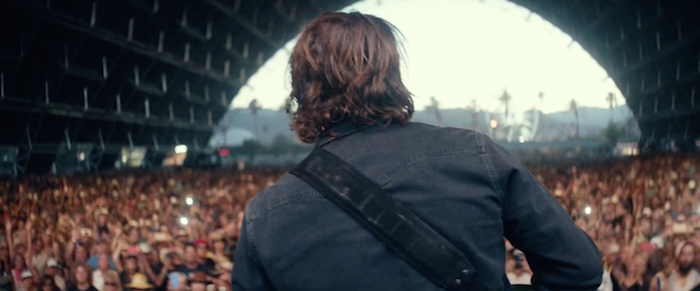 The story is initially told through, and amidst, relationships between artists and audiences, which Cooper captures vividly, honestly, and directly. At Jackson's initial performance, the crowd pulsates as much as the stage lights, waving through a blurry, exaggerated lens curvature — courtesy of director of photography Matthew Libatique — as if Jackson's drugs of choice (and occasional swigs of alcohol) help him channel their energy.Hard cut to: Jackson closing his car door on the lights, people, and adoration, growing increasingly flustered, and heading straight for the bottle. In under three minutes, Cooper expertly defines the strained relationship between Jackson and his stardom, a symbiosis sustained through substance.Whenever Jackson watches Ally perform — "La Vie en Rose" at the drag bar, a draft of "Shallow" outside a supermarket — Cooper plays audience to both Gaga's trepidations and her brief moments of freedom, looking up at her as she dances on the bar, or stands in front of him in the parking lot. In either case, Jackson is afforded the narrative perspective (we see Ally through his eyes; the edit favors him through close-ups, which show him growing increasingly calm) and in the process, Cooper gives us the Jackson-as-audience setup this story needs.These open spaces become stages as well. Once Jackson's relationship to Ally, and to the stage, is visually clarified, the film reaches its first rousing emotional culmination.
The story is initially told through, and amidst, relationships between artists and audiences, which Cooper captures vividly, honestly, and directly. At Jackson's initial performance, the crowd pulsates as much as the stage lights, waving through a blurry, exaggerated lens curvature — courtesy of director of photography Matthew Libatique — as if Jackson's drugs of choice (and occasional swigs of alcohol) help him channel their energy.Hard cut to: Jackson closing his car door on the lights, people, and adoration, growing increasingly flustered, and heading straight for the bottle. In under three minutes, Cooper expertly defines the strained relationship between Jackson and his stardom, a symbiosis sustained through substance.Whenever Jackson watches Ally perform — "La Vie en Rose" at the drag bar, a draft of "Shallow" outside a supermarket — Cooper plays audience to both Gaga's trepidations and her brief moments of freedom, looking up at her as she dances on the bar, or stands in front of him in the parking lot. In either case, Jackson is afforded the narrative perspective (we see Ally through his eyes; the edit favors him through close-ups, which show him growing increasingly calm) and in the process, Cooper gives us the Jackson-as-audience setup this story needs.These open spaces become stages as well. Once Jackson's relationship to Ally, and to the stage, is visually clarified, the film reaches its first rousing emotional culmination.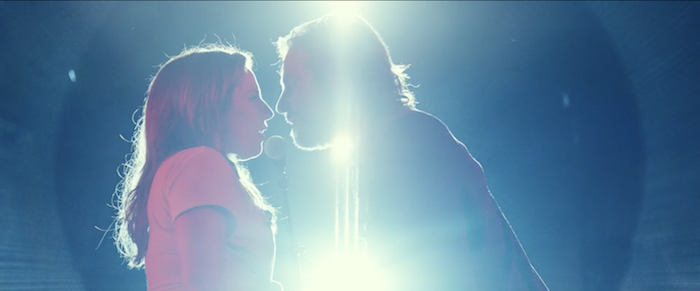
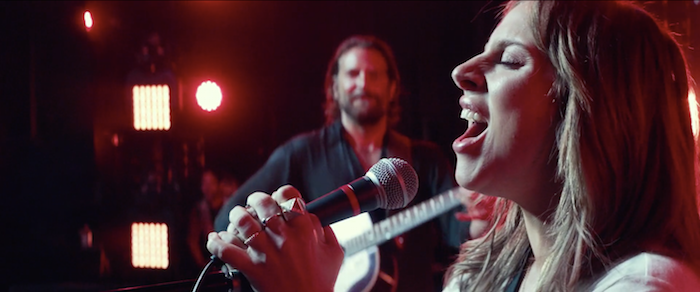 Before she walks on stage, Ally is given the narrative power in this scene, even though as the celebrity, Jackson holds more social currency in the fictional world. We enter the arena with Ally. We see Jackson's performance through her perspective, from the wings. The major dilemma driving the plot forward — whether or not Ally will join Jackson on stage — is told entirely through Gaga's close-ups.Once Ally takes the stage, Jackson veers between audience and performer himself. Sometimes he shares the spotlight with Ally — their chemistry while sharing the mic is incredible; they're so close they could kiss — other times, Jackson steps out of frame, or out of focus, watching her as he did at the bar.His relationship to his own stardom, and to the audience, has become visually irrelevant. We no longer see how he feels about the crowd, because he doesn't seem to care. He passes the torch to Ally, who accepts it fearlessly. In this moment, per the language of the film, one star is born, as another willingly fades from the spotlight. Were these 40 or so minutes the film's entirety, A Star is Born would be one for the history books.Unfortunately, this is barely the film's first third. From this point on, as the story leaves the stage behind, and Cooper is unable to lean on the artist-audience relationship for his visual framing, things begin to fall apart.Hints of the film's broken drama appear even before the "Shallow" scene; they don't stand out at first, but they're red flags in retrospect. Jackson's brother Bobby (Sam Elliott) is introduced as he approaches the stage. As Jackson rehearses, we feel Bobby's disapproval even without seeing Elliott's face, simply through his stern walk and the way he moves his head.
Before she walks on stage, Ally is given the narrative power in this scene, even though as the celebrity, Jackson holds more social currency in the fictional world. We enter the arena with Ally. We see Jackson's performance through her perspective, from the wings. The major dilemma driving the plot forward — whether or not Ally will join Jackson on stage — is told entirely through Gaga's close-ups.Once Ally takes the stage, Jackson veers between audience and performer himself. Sometimes he shares the spotlight with Ally — their chemistry while sharing the mic is incredible; they're so close they could kiss — other times, Jackson steps out of frame, or out of focus, watching her as he did at the bar.His relationship to his own stardom, and to the audience, has become visually irrelevant. We no longer see how he feels about the crowd, because he doesn't seem to care. He passes the torch to Ally, who accepts it fearlessly. In this moment, per the language of the film, one star is born, as another willingly fades from the spotlight. Were these 40 or so minutes the film's entirety, A Star is Born would be one for the history books.Unfortunately, this is barely the film's first third. From this point on, as the story leaves the stage behind, and Cooper is unable to lean on the artist-audience relationship for his visual framing, things begin to fall apart.Hints of the film's broken drama appear even before the "Shallow" scene; they don't stand out at first, but they're red flags in retrospect. Jackson's brother Bobby (Sam Elliott) is introduced as he approaches the stage. As Jackson rehearses, we feel Bobby's disapproval even without seeing Elliott's face, simply through his stern walk and the way he moves his head.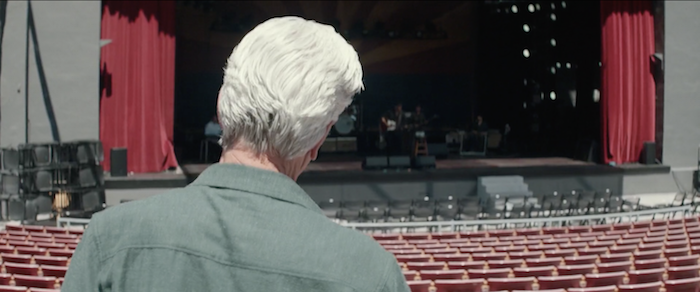
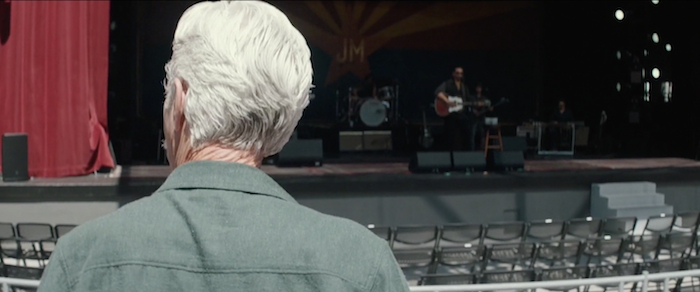 Bobby doesn't look up at Jackson's performance. He either stares down, in contemplation, or looks off to the side as he approaches him. Cooper captures most stage performances in fluid takes, letting their energy dictate the scene. The technique continues here to great effect, as the camera follows Bobby down the arena aisle, gazes up at Jackson over his shoulder, then spins around and moves up on to the stage, before looking down at Bobby over Jackson's shoulder.In a few short seconds, we understand Bobby's hesitance as he tries to get Jackson to wear his hearing aids. And as they exchange dialogue, we're brought into Jackson's perspective, as he looks down on Bobby and refuses to listen.But then, something strange and jarring occurs. The film momentarily cuts to a wide two-shot, for less than two seconds, filmed at a different time of day (the characters are no longer in shadow) and with Bobby's arm in a different position, as Jackson turns to walk away, before cutting back to the original angle of Jackson looking down on Bobby and smoothly returning to Bobby's perspective.
Bobby doesn't look up at Jackson's performance. He either stares down, in contemplation, or looks off to the side as he approaches him. Cooper captures most stage performances in fluid takes, letting their energy dictate the scene. The technique continues here to great effect, as the camera follows Bobby down the arena aisle, gazes up at Jackson over his shoulder, then spins around and moves up on to the stage, before looking down at Bobby over Jackson's shoulder.In a few short seconds, we understand Bobby's hesitance as he tries to get Jackson to wear his hearing aids. And as they exchange dialogue, we're brought into Jackson's perspective, as he looks down on Bobby and refuses to listen.But then, something strange and jarring occurs. The film momentarily cuts to a wide two-shot, for less than two seconds, filmed at a different time of day (the characters are no longer in shadow) and with Bobby's arm in a different position, as Jackson turns to walk away, before cutting back to the original angle of Jackson looking down on Bobby and smoothly returning to Bobby's perspective.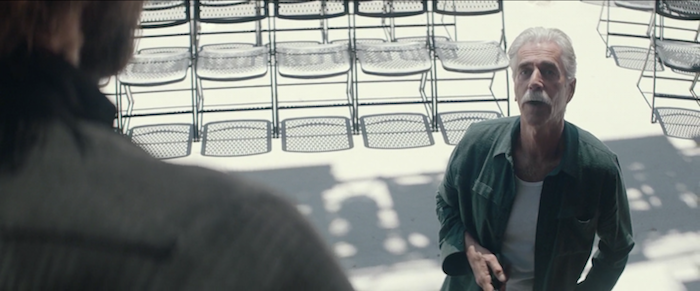
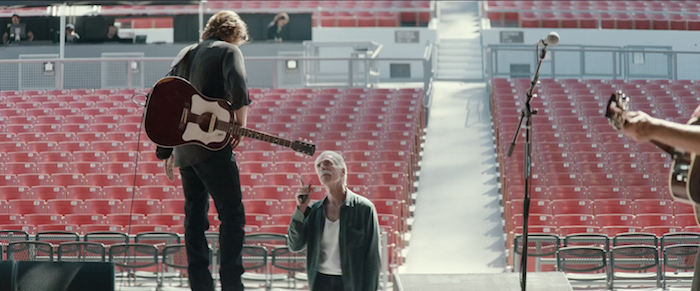 This bizarre insert and break in continuity could exist for any number of creative reasons — perhaps Cooper, or editor Jay Cassidy, decided to skip over bits of the unbroken take that either weren't working, or were breaking the flow of the scene — but the resultant cut is at a remove from the characters and their drama. Nitpicking continuity errors in and of themselves has little value, but here, the inserted shot captures neither the physical or emotional dynamic between the characters, nor the way they exist within the space around them. The lapse in continuity only highlights this all the more.It's a minor issue in the moment (if one at all), but it's emblematic of the film's later failings. When Jackson takes Ally to visit his childhood home, the scene ends on a close-up of Jackson kneeling down to feel the dirt, a visual image often associated with rustic nostalgia. There's no reason to think the intent is anything otherwise, since there's no close-up to convey what he's feeling in this moment, or a point-of-view shot to establish what he's even looking at (things that could, in theory, have also been conveyed through the performance in kneeling close-up, but aren't).When the film subsequently cuts to Jackson punching Bobby in a fit of rage, it takes Jackson yelling, "You sold dad's ranch? They turned it into a fucking wind-farm!" after the assault to clarify not only the logistics of the prior scene, but the emotions, and what actually leads to this exchange. This scene does eventually reach a point of dramatic potency once it frames Cooper and Elliott either in individual close-ups or a tight two-shot, but it needs to regain its balance before doing so. This is the case with several scenes in the film, wherein the physical relationship between any two characters is initially unclear, making it difficult to discern what their emotions are.
This bizarre insert and break in continuity could exist for any number of creative reasons — perhaps Cooper, or editor Jay Cassidy, decided to skip over bits of the unbroken take that either weren't working, or were breaking the flow of the scene — but the resultant cut is at a remove from the characters and their drama. Nitpicking continuity errors in and of themselves has little value, but here, the inserted shot captures neither the physical or emotional dynamic between the characters, nor the way they exist within the space around them. The lapse in continuity only highlights this all the more.It's a minor issue in the moment (if one at all), but it's emblematic of the film's later failings. When Jackson takes Ally to visit his childhood home, the scene ends on a close-up of Jackson kneeling down to feel the dirt, a visual image often associated with rustic nostalgia. There's no reason to think the intent is anything otherwise, since there's no close-up to convey what he's feeling in this moment, or a point-of-view shot to establish what he's even looking at (things that could, in theory, have also been conveyed through the performance in kneeling close-up, but aren't).When the film subsequently cuts to Jackson punching Bobby in a fit of rage, it takes Jackson yelling, "You sold dad's ranch? They turned it into a fucking wind-farm!" after the assault to clarify not only the logistics of the prior scene, but the emotions, and what actually leads to this exchange. This scene does eventually reach a point of dramatic potency once it frames Cooper and Elliott either in individual close-ups or a tight two-shot, but it needs to regain its balance before doing so. This is the case with several scenes in the film, wherein the physical relationship between any two characters is initially unclear, making it difficult to discern what their emotions are.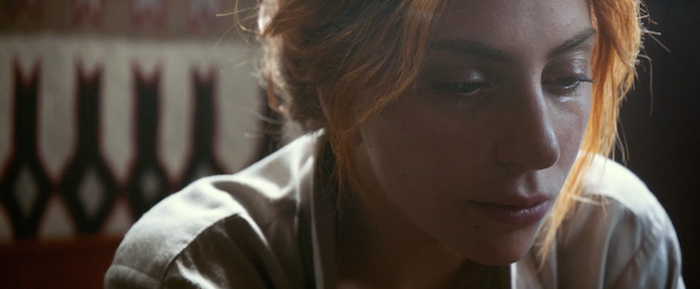
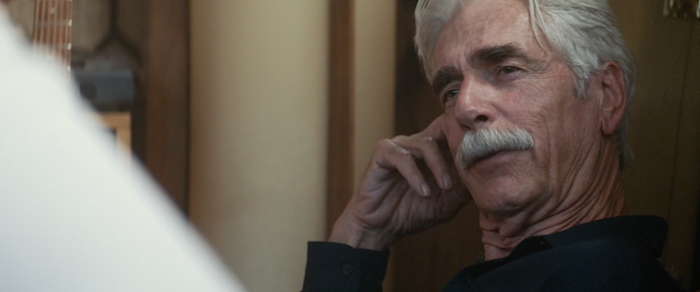 Toward the end of the film, as Ally and Bobby sit together on the floor of Ally's home, the scene begins tight and cuts between close-ups of the two characters. Given the way the characters are framed as they commiserate — Ally looking down and to the right; Bobby on the right, looking left and upward — the dynamic of the scenes comes off, initially, as a direct conversation. The scene cuts from Bobby's face to Ally's, and it feels as if the upsetting news they're exchanging connects them somehow, like there's some form of understanding between the characters.However, the emotional intent of the scene becomes something entirely different once the physical dynamic between them is clarified. Bobby enters the frame in Ally's closeup, retroactively reframing the subtext.
Toward the end of the film, as Ally and Bobby sit together on the floor of Ally's home, the scene begins tight and cuts between close-ups of the two characters. Given the way the characters are framed as they commiserate — Ally looking down and to the right; Bobby on the right, looking left and upward — the dynamic of the scenes comes off, initially, as a direct conversation. The scene cuts from Bobby's face to Ally's, and it feels as if the upsetting news they're exchanging connects them somehow, like there's some form of understanding between the characters.However, the emotional intent of the scene becomes something entirely different once the physical dynamic between them is clarified. Bobby enters the frame in Ally's closeup, retroactively reframing the subtext.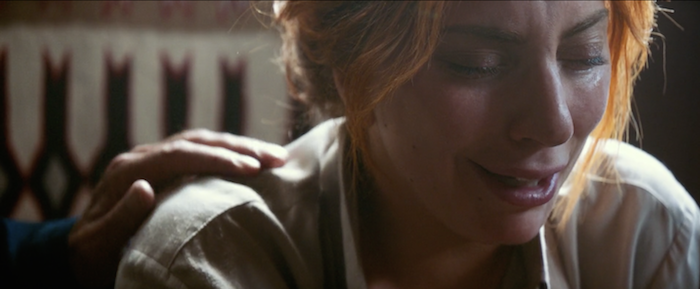 The two weren't actually face-to-face. Bobby was seated behind her. It takes a moment to re-orient the perspective on what's going on. The two weren't connecting; rather Ally was devastated to the point of being unable to maintain eye contact, and Bobby was trying to reach out to her. It takes this physical clarification at the very end of the exchange (rather than bringing the audience into the characters' perspectives after first establishing them, or even simply framing Bobby on the left) to figure out the scene is about Ally's isolation.This spatial muddling permeates the film throughout, stifling what ought to be clear and affecting emotional moments. However, the emotions of each scene are still clarified to a large degree by the actors – enough that a precise understanding of the subtext and dynamics don't always matter.The reason the film's opening scene works perfectly is the same reason its scenes of interpersonal dynamic feel off-balance. Cooper, the actor's director, masterfully externalizes the thoughts, feelings and insecurities of the individual, though for the most part, he struggles to connect the same between two people in any visual sense.The "actor's director" element is key. Gaga, Elliott, and Cooper the actor all deliver tremendous performances; Cooper the director loves their faces and bodies, and rightly so. While he struggles to orient them in time and place (and thus, in an emotional equilibrium going into a given scene, one that's either going to be re-affirmed or upset), he clarifies their emotions when most scenes enter close-ups or tight two-shots, like the altercation between Bobby and Jackson...
The two weren't actually face-to-face. Bobby was seated behind her. It takes a moment to re-orient the perspective on what's going on. The two weren't connecting; rather Ally was devastated to the point of being unable to maintain eye contact, and Bobby was trying to reach out to her. It takes this physical clarification at the very end of the exchange (rather than bringing the audience into the characters' perspectives after first establishing them, or even simply framing Bobby on the left) to figure out the scene is about Ally's isolation.This spatial muddling permeates the film throughout, stifling what ought to be clear and affecting emotional moments. However, the emotions of each scene are still clarified to a large degree by the actors – enough that a precise understanding of the subtext and dynamics don't always matter.The reason the film's opening scene works perfectly is the same reason its scenes of interpersonal dynamic feel off-balance. Cooper, the actor's director, masterfully externalizes the thoughts, feelings and insecurities of the individual, though for the most part, he struggles to connect the same between two people in any visual sense.The "actor's director" element is key. Gaga, Elliott, and Cooper the actor all deliver tremendous performances; Cooper the director loves their faces and bodies, and rightly so. While he struggles to orient them in time and place (and thus, in an emotional equilibrium going into a given scene, one that's either going to be re-affirmed or upset), he clarifies their emotions when most scenes enter close-ups or tight two-shots, like the altercation between Bobby and Jackson...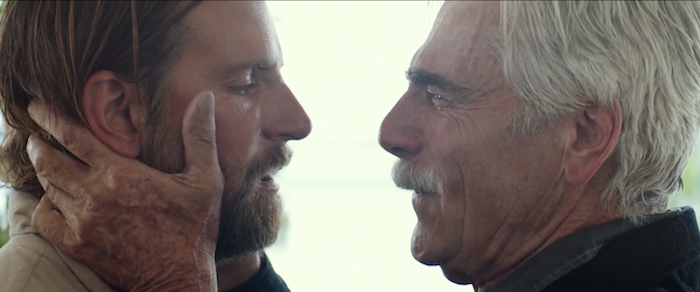 ...or the incendiary argument with Ally in a bathtub, an intoxicated Jackson leaning over her to berate her. In either scene, the actors' physicality dictates the rhythm. Editor Cassidy holds the tension between the performers as they veer in and out of each other's orbits, something that never quite comes to fruition in medium or wide shots, since Cooper is unable to use these shots to the same dramatic effect.The drunken argument between Ally and Jackson works as soon as Jackson sits at the edge of the bathtub. Cooper, who often leans in the film to compensate for Jackson's poor hearing, now leans in order to tower over Ally. He sits in a fixed position of power over her, un-moving, taking up more than half of the frame. The camera on him stays locked off, since he strays neither from his physical nor emotional position.
...or the incendiary argument with Ally in a bathtub, an intoxicated Jackson leaning over her to berate her. In either scene, the actors' physicality dictates the rhythm. Editor Cassidy holds the tension between the performers as they veer in and out of each other's orbits, something that never quite comes to fruition in medium or wide shots, since Cooper is unable to use these shots to the same dramatic effect.The drunken argument between Ally and Jackson works as soon as Jackson sits at the edge of the bathtub. Cooper, who often leans in the film to compensate for Jackson's poor hearing, now leans in order to tower over Ally. He sits in a fixed position of power over her, un-moving, taking up more than half of the frame. The camera on him stays locked off, since he strays neither from his physical nor emotional position.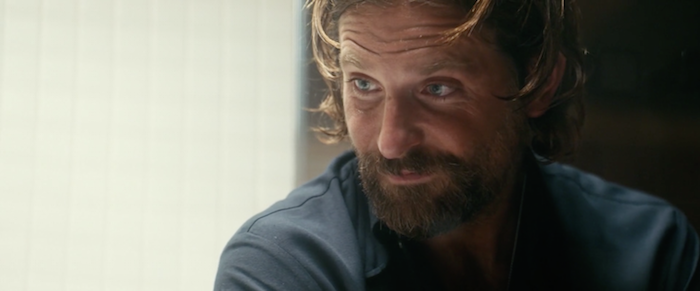 The way Ally is framed, however, follows Gaga's every movement. She begins in the corner of the frame, powerless, before becoming the scene's energetic focal point, rebuking Jackson's challenges.
The way Ally is framed, however, follows Gaga's every movement. She begins in the corner of the frame, powerless, before becoming the scene's energetic focal point, rebuking Jackson's challenges.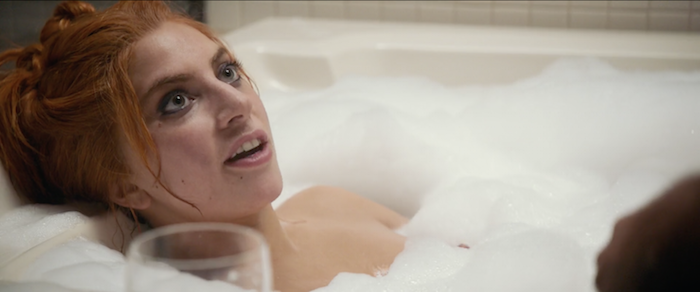
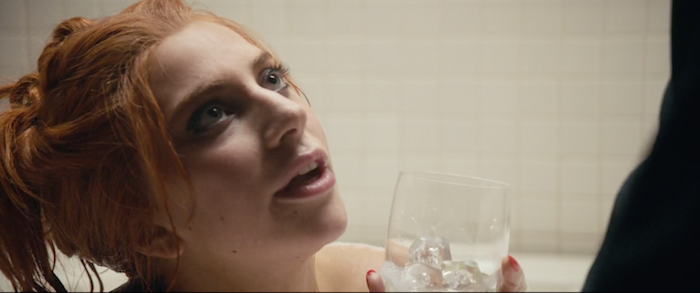 Both performers shoulder the weight of the story. What Cooper lacks in ability to visually frame subtext, he makes up for by bringing out, in both himself and Gaga, subtext through voice and posture. Cooper's Jackson feels like a cheap imitation of Sam Elliott, as if in attempt to replicate his hardened exterior. Gaga, who code switches subtly between her home and public life (she sounds more Italian-American when acting opposite her father, played by Andrew Dice Clay), delivers a physical performance in sharp contrast to the resolute Cooper, capturing each scene through movement.Sam Elliott's performance as Bobby is crafted in even further contrast to the two leads. Where Gaga and Cooper express themselves — Gaga, freely, and Cooper, reaching out from behind Jackson's crumbling exterior — Bobby's constant composure, compared to his alcoholic brother, means Elliott has to speak subtly through his eyes. He has entire conversations through his tears alone, as he struggles to hold them back, and they push their way through regardless.Were a film composed entirely of close-ups more commercially viable — imagine A Star is Born by way of Tsai Ming-liang, or La Passion de Jeanne d'Arc — then Cooper would likely find himself in the directors' hall of fame. But Cooper's focus, for better or worse, seems to be crafting traditionally Hollywood stories. Which, at their very best, succeed at an outside-in approach. It's the outside part — the bookends, the framing, the "Meanwhile..." that supports each scene —that Cooper hasn't quite put his finger on.Whatever wins at the Oscars this Sunday, A Star is Born will likely remain an artifact of Bradley Cooper's early career. A sign of things to come, once he hopefully hones his visual craft, and a promise of unmistakable dramatic talent as a director of human emotions up close.
Both performers shoulder the weight of the story. What Cooper lacks in ability to visually frame subtext, he makes up for by bringing out, in both himself and Gaga, subtext through voice and posture. Cooper's Jackson feels like a cheap imitation of Sam Elliott, as if in attempt to replicate his hardened exterior. Gaga, who code switches subtly between her home and public life (she sounds more Italian-American when acting opposite her father, played by Andrew Dice Clay), delivers a physical performance in sharp contrast to the resolute Cooper, capturing each scene through movement.Sam Elliott's performance as Bobby is crafted in even further contrast to the two leads. Where Gaga and Cooper express themselves — Gaga, freely, and Cooper, reaching out from behind Jackson's crumbling exterior — Bobby's constant composure, compared to his alcoholic brother, means Elliott has to speak subtly through his eyes. He has entire conversations through his tears alone, as he struggles to hold them back, and they push their way through regardless.Were a film composed entirely of close-ups more commercially viable — imagine A Star is Born by way of Tsai Ming-liang, or La Passion de Jeanne d'Arc — then Cooper would likely find himself in the directors' hall of fame. But Cooper's focus, for better or worse, seems to be crafting traditionally Hollywood stories. Which, at their very best, succeed at an outside-in approach. It's the outside part — the bookends, the framing, the "Meanwhile..." that supports each scene —that Cooper hasn't quite put his finger on.Whatever wins at the Oscars this Sunday, A Star is Born will likely remain an artifact of Bradley Cooper's early career. A sign of things to come, once he hopefully hones his visual craft, and a promise of unmistakable dramatic talent as a director of human emotions up close.
